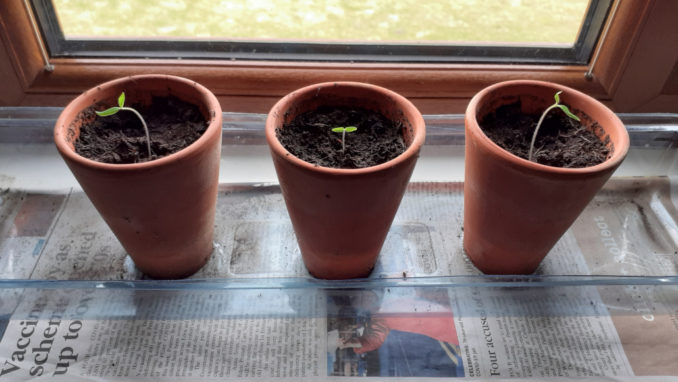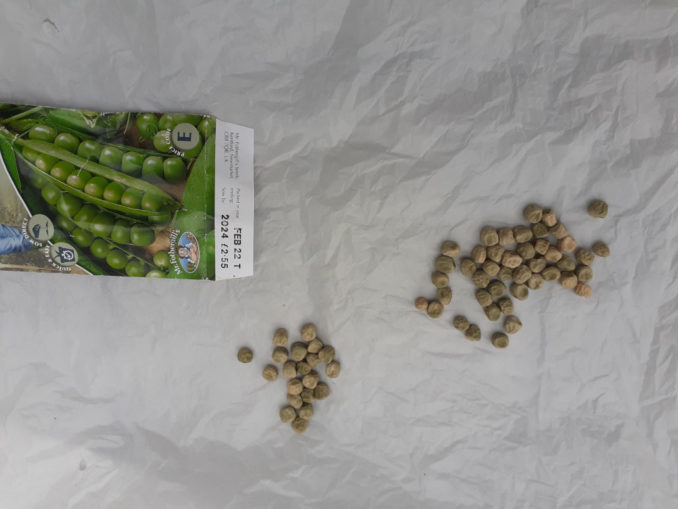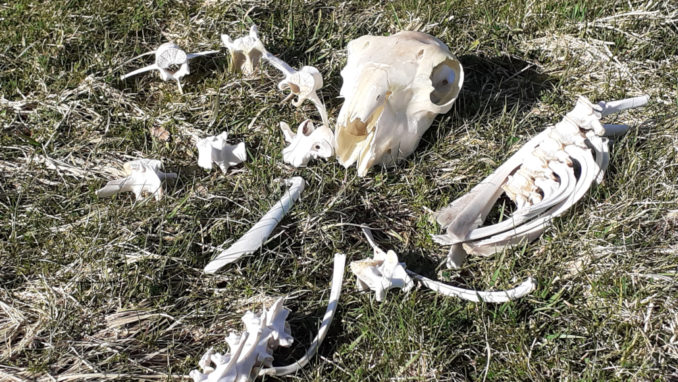
© Colin Cross, Going Postal 2021
The “art” of growing vegetables isn’t all about the act itself. If it were, we’d all be doing it and shops (especially greengrocers) wouldn’t exist. As is probably apparent, I take a somewhat relaxed attitude into the greenhouse with me. In the early stages of the growing year, periods of quiet contemplation (not just about the growing itself), are equally as important as the digging, muck spreading, crop choosing, sowing, transplanting and weed killing. To be honest weeds, which are natures litter, drive me to absolute distraction. Whatever I try doesn’t work, so this year I’m taking a different tack. I’m going to employ, pro bono, the soon to be (early retired) retired Mrs. C. It’s about time she pulled her weight and, as she sees weeds as a challenge to be met head on, unlike myself, I’m putting her in sole charge of their control. I just have to hope she doesn’t use her two pronged weeding tool on me, I can be an annoying so and so.

© Colin Cross, Going Postal 2021
As I’ve mentioned earlier, I’m starting things off a little earlier this year, due to having a new cold frame in place. Early days yet but there are leeks, chili’s, long peppers, mini cucumbers (for pickling, hopefully) and yellow courgettes. I do know how many of you view the humble courgette and understand some of the reservations, but it serves several useful purposes, as, hopefully, we shall see in the fullness of time. I’ve never had much success growing leek from seed when sowing direct, consequently I’ve tended to buy them in trays, grow them on as much as I dare then carefully untangle the roots before transplanting them into a prepared plot. I’m taking a slightly different approach this year, as it looks unlikely that the small plant stall (with honesty box) is going to appear outside one of my neighbours houses as it has done in recent years. Who knows, there might be a bit of beer money to be made.

© Colin Cross, Going Postal 2021
Being a Yorkshire man, something which remains as part of the psyche no matter how far one travels or where one eventually settles down, I’m always loathe to part with anything that may be of future use. Sometimes I even spot the potential in something many years before any possible usefulness becomes apparent. My garage offers clear testament to this. Every year I’ve dried my own peas to provide seed for future planting, the same as I do with tomatoes. For whatever reason, frustration with my inability to use my right arm properly or just general ennui, I decide I wasn’t going to grow peas this year. Utter madness, although tomatoes are my prize crop there is little to compare with a handful of peas picked fresh and eaten, straight from the pod. Long story short, after a little consideration and following the realisation that there was space for a row of something between the beans and the path I had a change of heart. A pity I didn’t make the change sooner, all my seed peas had been destroyed in one of the regular garage tidying sprees. At £2.55 for 60 seed peas, I doubt I’ll make the same mistake again.

© Colin Cross, Going Postal 2021
Although there’s always been a sieve in the greenhouse I’ve never really seen a need to use such a tool. The rotovator makes a decent enough fist of breaking up the soil for most needs and any clods which are left lying, or dug out when I’m trenching, are usually easily taken care of with a good smack with the back of my trusty old spade. Having time on my hands and with two females permanently in the house during the day has meant me doing things which, up until this “lock down” I wouldn’t have previously considered, hence the sieving of the top soil. Although it’s time consuming it doesn’t require a great deal of mental application, allowing the siever time for reflection, but what to reflect on? The sheer waste of money and time that was the Nightingale Hospital farrago, given even if they had been needed they would have been impossible to staff? The insistence on mask wearing, even though many eminent medical professionals, along with the WHO, cast doubt on their efficacy? The lack of bio-hazard bins to dispose of said masks, given the received wisdom is that they’re contaminated with a silent, virulent killer? Or even the obscene amounts of money that have lined the pockets of opportunists and cronies? Or maybe the preponderance of vapid 3 word slogans that seem to presage a future none of us want but seem powerless to do anything about?

© Colin Cross, Going Postal 2021
I’ve adapted my daughters windowsill to take the place of Normans patio doors. She’s slightly miffed, as she contends it’ll play havoc with the “feng shui” of her room. As she’s been down in Suffolk, visiting her sister for a couple of weeks I tend to think, so long as I get them moved before she gets home, any “feng shui” being disturbed will be akin to that tree falling in the woods that no one heard. As I write this most of these seedlings are ready for potting on into 4 inch pots, before being moved into the cold frame for a couple of weeks, although the prospect of a cold snap makes me rather nervous. Tomatoes, as many of you will know, can’t abide a frost.

© Colin Cross, Going Postal 2021
Having sieved the topsoil I used it to cover both the rows of mixed beans and peas. Planting seeds directly into the soil, rather than in trays and then further transplanting the seedlings is something I first tried last year. It worked well, so I’m hoping for a similar outcome. I’ve only put 20 peas in, if they don’t all germinate I’ll add to them. I’m also hoping that an early planting and hopefully early harvest will mean better cropping. Peas, from my experience, don’t get on well with the intense heat which can occur under glass. I do have an idea to try and better protect this area of the greenhouse from the heat of the day, more about that later.

© Colin Cross, Going Postal 2021
I took a little walk along the old railway line and into what Norman always called his “back fields”. The raised embankment is what’s left of the Penrith-Keswick-Cockermouth line, the last section of which (Penrith to Keswick) closed in 1972. Mrs. C has fond memories of trips into Penrith with her dad. What a boon for the local economy it would be if the line was still operating today. A section has opened, between Threlkeld and Keswick, for walkers. I’ve walked it a couple of times and it’s a decent enough stroll, but all hope of ever reopening the line and running steam engines along it has now faded, much to the disappointment of many people. The track itself has gone, but where it ran is now overgrown and difficult to negotiate in places, there is lots of fence wire lurking in the undergrowth and there are air vents, cunning placed and cleverly hidden, just waiting for the unwitting explorer to go backside over breakfast time and end up either extricating themselves from a clump of thorn brambles or, maybe worse, ending up in one of the stagnant ponds that line the raised embankment. I walked back through the fields, where I came across the bleached remains of a sheep, which must have lain there for some time, given it had been picked clean by birds and animals. Another moment for reflection on times passed. The fields are let for grazing, but when Norman had his flock, any sheep that died in a field, although roundly and comprehensively cursed, would have been either taken away by the “Fallen Stock Man” or buried deep enough to keep scavengers away. Such, I suppose, is life (and death).
Next time; More of the same…
© Colin Cross 2021
The Goodnight Vienna Audio file
Audio Player



